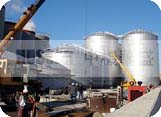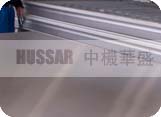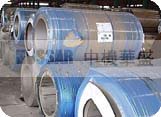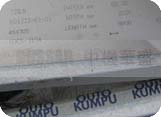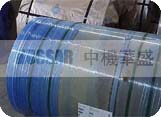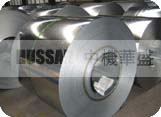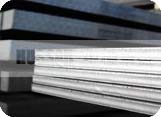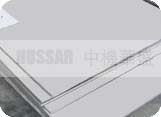| 2205 Duplex/Super
Duplex Stainless Steel (1.4462,UNS S31803/UNS S32205)
The yield strength
is about twice that of austenitic stainless steels, thus allowing a designer to
save weight and making the alloy more cost competitive when compared to 316L or
317L.
Alloy 2205 (UNS S32305/S31803) is a 22% chromium, 3% molybdenum, 5-6%
nickel, nitrogen alloyed duplex stainless steel with high general, localized,
and stress corrosion resistance properties in addition to high strength and excellent
impact toughness.
Alloy 2205 provides
pitting and crevice corrosion resistance superior to 316L or 317L austenitic stainless
steels in almost all corrosive media. It also has high corrosion and erosion fatigue
properties as well as lower thermal expansion and higher thermal conductivity
than austenitic. ------------------------------------------------------------------
Applications
Fields:
Value Added Processes:
Plasma Cutting
Abrasive Waterjet Cutting
Machincut
Saw Cut
Drilling,
Tapping,
Counterboring
Milling
Polishing
Flattening
Rolled & Welded Rings
------------------------------------------------------------------
Product
Information:
E-Z Drill Plate
Vacuum Select Plate
High Performance
Nickel Alloys
Hub-Less Plate Flanges
Wide Plate
Duplex Stainless Plate
------------------------------------------------------------------ General
Properties
Alloy 2205 is a 22% Chromium, 3% Molybdenum, 5-6% Nickel nitrogen
alloyed duplex stainless steel with high general, localized and stress corrosion
resistance properties in addition to high strength and excellent impact toughness. Alloy
2205 provides pitting and crevice corrosion resistance superior to 316L or 317L
austenitic stainless steels in almost all corrosive media. It also has high corrosion
and erosion fatigue properties as well as lower thermal expansion and higher thermal
conductivity than austenitic. The
yield strength is about twice that of austenitic stainless steels. This allows
a designer to save weight and makes the alloy more cost competitive when compared
to 316L or 317L. Alloy 2205 is particularly
suitable for applications covering the -50F/+600F temperature range. Temperatures
outside this range may be considered but need some restrictions, particularly
for welded structures.
------------------------------------------------------------------ Applications Pressure
vessels, tanks, piping, and heat exchangers in the chemical processing industry
Piping, tubing, and heat exchangers for the handling of gas and oil
Effluent scrubbing systems
Pulp and paper industry digesters, bleaching equipment,
and stock-handling systems
Rotors, fans, shafts, and press rolls requiring
combined strength and corrosion resistance
Cargo tanks for ships and trucks
Food processing equipment
Biofuels plants
------------------------------------------------------------------ Standards
ASTM/ASME...........A240 UNS S32205/S31803
EURONORM...........1.4462 X2CrNiMoN
22.5.3
AFNOR...................Z3 CrNi 22.05 AZ
DIN.........................W.
Nr 1.4462 ------------------------------------------------------------------ Corrosion
Resistance
General Corrosion
Because of its high chromium (22%), molybdenum
(3%), and nitrogen (0.18%) contents, the corrosion resistance properties of 2205
are superior to that of 316L or 317L in most environments. Stress
Corrosion Resistance
The duplex microstructure is known to improve the
stress corrosion cracking resistance of stainless steels. Chloride
stress corrosion cracking of austenitic stainless steels can occur when the necessary
conditions of temperature, tensile stress, oxygen, and chlorides are present.
Since these conditions are not easily controlled, stress corrosion cracking has
often been a barrier to utilizing 304L, 316L, or 317L. Corrosion
Fatigue Resistence
Alloy 2205 combines high strength and high corrosion
resistance to produce high corrosion fatigue strength. Applications in which processing
equipment is subject to both an aggresively corrosive enviroment and to cycle
loading can benefit from the properties of 2205. ------------------------------------------------------------------ Chemical
Analysis
Typical values (Weight %) C
Cr Ni Mo N Others
0.020 22.1 5.6 3.1 0.18 S=0.001
PREN = [Cr%] = 3.3
[Mo%] = 16 [N%] ≥ 34 ------------------------------------------------------------------ Mechanical
Properties
Mechanical Properties at Room Temperature
ASTM A 240 Typical
Yield Strength 0.2%, ksi 65 min. 74
Tensile Strength,
ksi 90 min. 105
Elongation % 25 min. 30
Hardness HB 293 max. 256 ------------------------------------------------------------------ Structure
The chemical analysis of 2205 is optimized to obtain a typical 50 a/ 50 g microstructure
after solution annealing treatment at 1900/1922F (1040/1080C). Heat
treatments performed above 2000F may result in an increase of ferrite content. Like
all duplex stainless steels, 2205 is susceptible to precipitation of intermetallic
phases, usually referred to as sigma phase. Intermetallic phases precipitate in
the range of 1300F to 1800F, with the most rapid precipitation occurring at about
1600F. Thus, it is prudent to have 2205 pass a test for the absence of intermetallic
phases, such as those in ASTM A 923.
------------------------------------------------------------------ Processing
Hot Forming
Forming below 600F is recommended whenever possible. When hot
forming is required, the workpiece should be heated uniformly and worked in the
range of 1750 to 2250F. Alloy 2205 is quite soft at these temperatures and is
readily formed. Above this range, 2205 is subject to hot tearing. Immediately
below this range, the austenite becomes substantially stronger than the ferrite
and may cause cracking, a particular danger to “cold” edges. Below 1700F there
can be rapid formation of intermetallic phases because of the combination of temperature
and deformation. Whenever hot forming is done, it should be followed by a full
solution anneal at 1900F minimum and rapid quench to restore phase balance, toughness,
and corrosion resistance. Stress relieving is not required or recommended; however,
if it must be performed, the material should receive a full solution anneal at
1900F minimum, followed by rapid cooling or water quenching. Cold
Forming
Alloy 2205 is readily sheared and cold formed on equipment suited
to working stainless steels. However, because of the high strength and rapid work
hardening of 2205, forces substantially higher than those for austenitic steels
are required to cold form 2205. Also because of the high strength, a somewhat
larger allowance must be made for springback. Heat
Treatment
Alloy 2205 should be annealed
at 1900F minimum, followed by rapid cooling, ideally by water quenching. This
treatment applies to both solution annealing and stress relieving. Stress relief
treatments at any lower temperature carry the risk of precipitation of detrimental
intermetallic or nonmetallic phases.
------------------------------------------------------------------ Machinability
With high-speed steel tooling, 2205 may be machined at the same feeds and speeds
as Alloy 316L. When carbide tooling is used, cutting speeds should be reduced
by about 20% relative to the speeds for Alloy 316L. Powerful machines and rigid
mounting of tools and parts are essential.
------------------------------------------------------------------ Welding
Alloy 2205 possesses good weldability. The goal of welding 2205 is that the weld
metal and heat-affected zone (HAZ) retain the corrosion resistance, strength,
and toughness of the base metal. The welding of 2205 is not difficult, but it
is necessary to design welding procedures that lead to a favorable phase balance
after welding and will avoid precipitation of detrimental intermetallic or nonmetallic
phases. 2205 can be welded by: GTAW
(TIG); GMAW (MIG); SMAW ("stick" electrode); SAW; FCW; and PAW. | 
